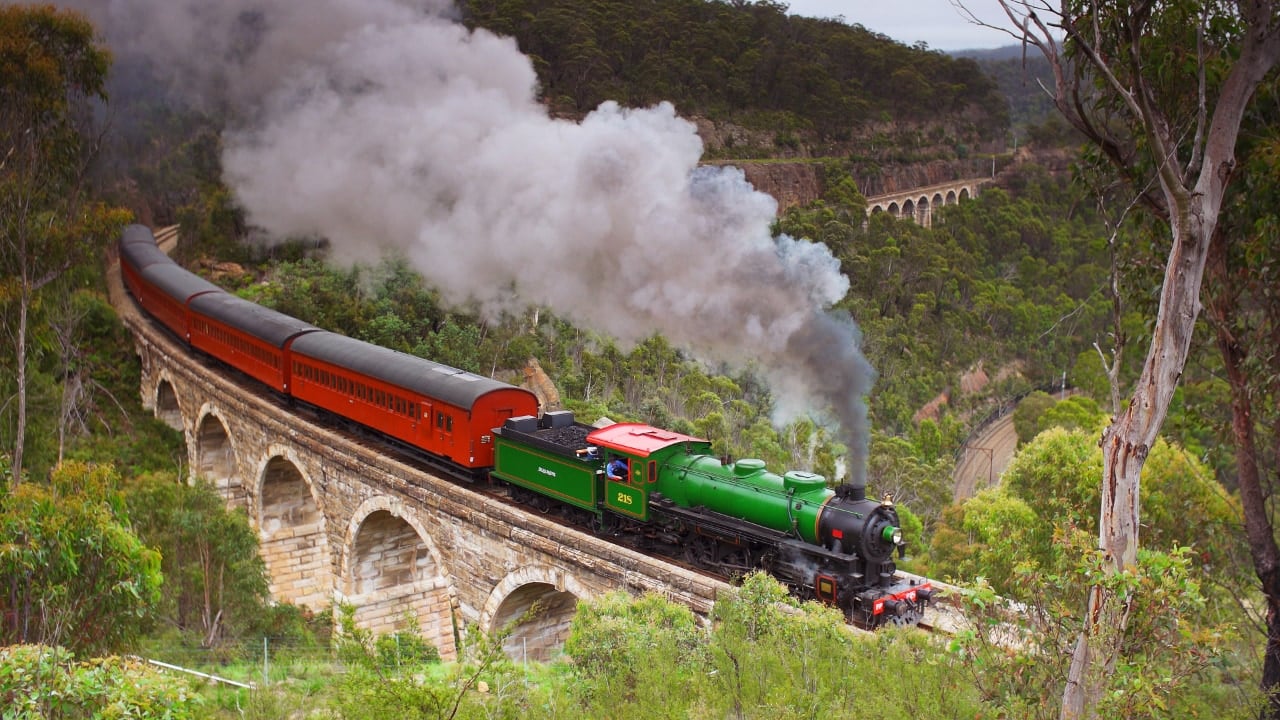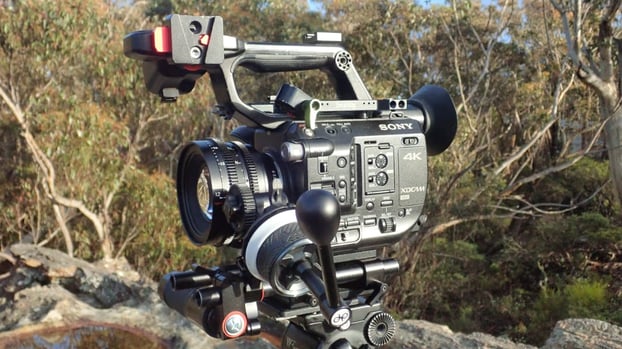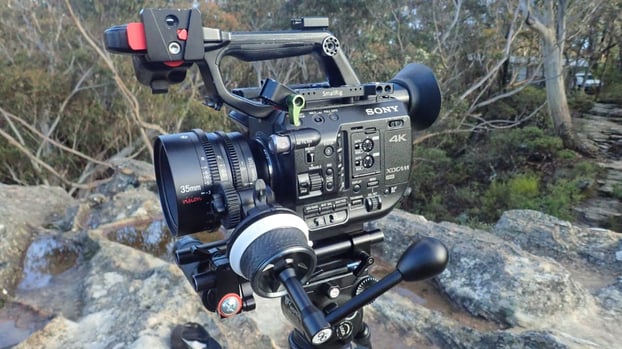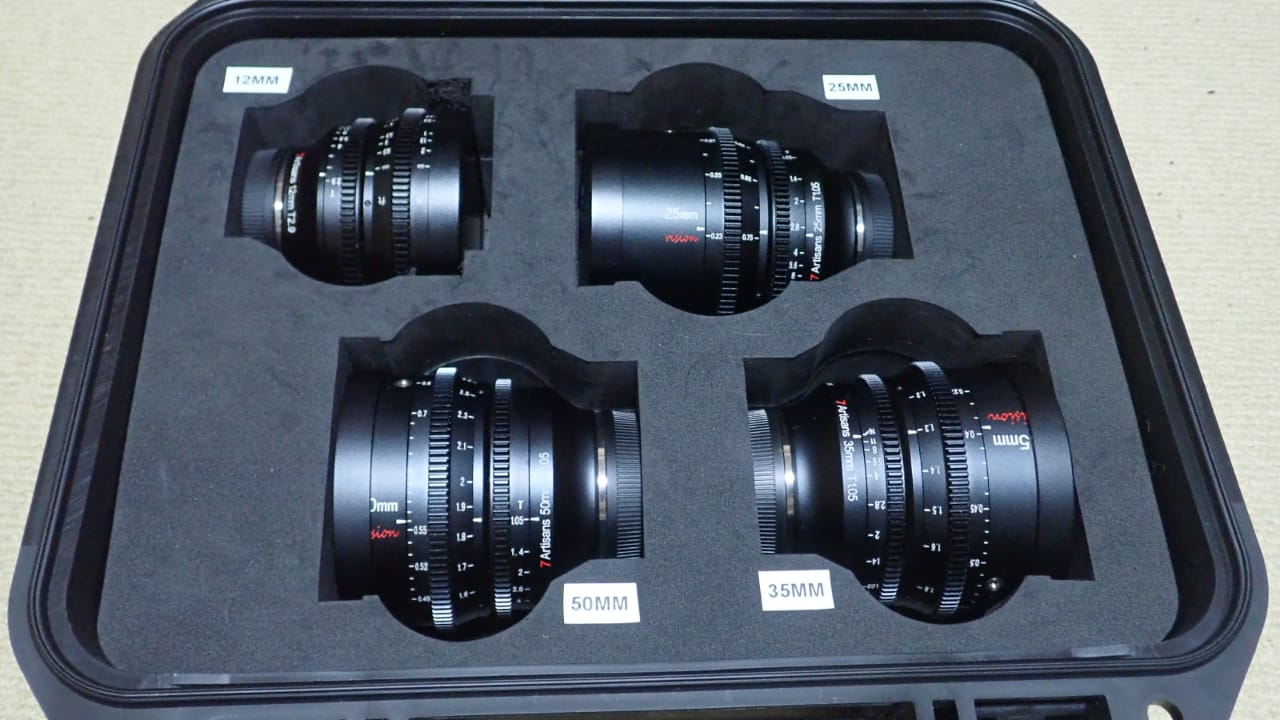
“These Primes are so darned fast; I’ll need an ND for night!” Craig Marshall bought himself a set of 7Artisans Vision Super35 Cinema Primes and he's impressed with the results.
Following on from a previous RedShark story detailing my acquisition of a bargain Sony FS5 then building it up for ENG-style use, I ultimately located a cheap Sony FS7 that came equipped with another PZ 18-110mm G F/4.0 constant aperture servo-zoom. I regularly operate both the FS5 and FS7 together, but as I will soon be conducting some interviews in very dark industrial workshops, I could see the coming need for at least one fast prime lens.
I had previously sold most of my collection of full-frame Carl Zeiss Contax vintage primes to finance my first 18-110mm E-Mount servo zoom, but one lens I retained was my coveted Zeiss 21mm Distagon f/2.8. This legendary Super Wide lens enjoys a speed of about F2.0 when adapted to a S35 sensor using a Metabones ‘Speed Booster’, so mounted on the FS5, the combination offers approximately an 85-degree AoV. This has proven particularly useful at, say, F/8.0, where I’m able to set the lens’ focus to infinity and then allow the FS5’s ‘floating’ internal electronic ND filter to set exposure adjustments which I can trim +/- 2 stops in real-time using the FS5’s hand-grip thumb dial.
A need for speed

The 7artisans 12mm T2.9 mounted on Craig's Sony FS5
I briefly tested a $600 vintage Contax 18mm F/4 prime lens on the Speed Booster but found it both too close in Angle of View to the 21mm, significantly slower and the lens was not internal focusing like the 21mm, so a lightweight, clip-on matte box for my 4 x 5.65” cine filters was out of the question. This was not proving to be an efficient solution, so I looked about to see if there were any worthwhile native Super 35 E-Mount fast wide-angle lenses on offer when I accidentally bumped across a 7Artisans 12mm, T2.9 Cinema Prime from its Vision series of Super 35 lenses asking just $240 brand new! 12mm on S35 has the same AoV as 18mm on Full Frame so at 100 degrees, it should offer a slight improvement over the long & clunky Zeiss 21mm/Speed Booster combo albeit not quite so fast.
7Artisans?
7Who? A cheap, Chinese wide-angle Cinema Prime? What could possibly go wrong! Could it be any good when compared with some of the finest vintage stills photography lenses?
We are warned that one man’s ‘Character Lens’ can be another man’s ‘Crap Lens’ but let’s get something straight: whilst I’m a fellow who is more interested in capturing the moment than out and out Pixel Peeping, stills photography lenses used for video will always be a compromise. They usually exhibit severe focus breathing, they will have segmented iris rotation with relatively few blades, they are rarely par focal, the front barrel often extends and/or rotates when focused, and the filter thread diameter will vary from lens to lens.
There is a plethora of videos on YouTube showing how one fellow or another has managed to cobble up a set of low-cost, almost matched ‘cinema primes’ from a variety of stills photography lenses with mixed success. However, true Cinema Prime lenses will show none of the above characteristics. So, when my 7Artisans 12mm T2.9 wide-angle lens arrived, I was keen to put it to the test. How would it compare with my vintage Zeiss 21mm Distagon, widely regarded as the best 21mm lens ever made - a classic, vintage stills lens, asking today, depending on condition, some $2-3,000 for a forty-year old example!
7Artisans 12mm T2.9
The 12mm T2.9 wide-angle lens is an all metal construction and comes with a beautifully machined, slip-on front metal lens cap with a plastic rear cap. The front glass does not rotate when focusing, nor does it extend. The filter screw thread is 82mm, so it readily accepts my lightweight SmallRig carbon-fibre matte box via one of the included adapter rings. IMO, these are essential accessories and are available now at such low cost, you could consider buying one for each of the glass filters you might have in your collection. Apart from a flare-reducing, contrast-improving lens hood, dropping and breaking just one glass filter on changeover can cost nearly 10x the cost of another matte box.
The 12mm outer barrel is clearly lettered in both feet and metres and is machined with standard .08 mod gears on both the focus and iris rings. It is important to note that the focus ring rotates slightly past Infinity. This is to allow for differing lens mount back-focus, so it’s wise to know exactly where your exact Infinity lies when the lens is wide open. (Back Focus differs slightly from my FS5 to FS7, even though they both share the same sensor and E-Mount.)

The Vision 35mm T1.05 is probably the most exciting lens in the collection
The 7Artisans Vision series of S35/APSC Primes is available for most modern video camera lens mounts, and some reviewers report one or more of the APSC series can be used on E-Mount Full Frame cameras with only minimal vignetting. Note though, that 7Artisans does offer a set of Full Frame T2.0 Cinema Primes in its Spectrum series. Both focus rotation and iris actions are remarkably smooth on the 12mm T2.9. The 9 bladed iris is de-clicked and it feels very smooth.
If it wasn’t obvious, the Vision series are all manual lenses but bear in mind these lenses are properly designed for manual operation, so are an entire world away from the frustration of trying to focus for video with stills lenses or horror of horrors, ‘fly by wire’ autofocus glass! The geared lens barrel encourages the use of a follow focus wheel where manual focusing becomes a breeze compared with fiddly alternatives.
Apart from the 100-degree Angle of View and acceptable T2.9 lens speed, the one thing that caught my attention was the very close focusing ability at just 140mm (about 5.51 in)! Focus rotation is a huge 270 degrees, but the printed scale (in both feet & metres) is logarithmic, so it is very unlikely you will ever need to pull focus over the full 270 degrees of rotation.
For my accompanying test video linked below, I fitted a crank handle to my focus wheel to perform a smooth, continuous focus pull. The video also checks for lens breathing and any corner softness.
The Full Monty!
I was so impressed with the performance & day to day usability of the 7Artisans 12mm T2.9 prime that I shot a sixty-minute documentary entirely on this wide-angle lens. Quite liberating: 100-degree Angle of View, Focus set to Infinity, Iris on T5.6 with the FS5 ‘floating’ automatic ND setting exposure. Soon after my documentary was published, I took a quick peek on-line one day to see if there were any more of the Vision series lenses available nearby.

It must have been my lucky day as a video pro up in Queensland was offering the complete package of three, unused 7Artisans Super 35 primes for sale, including the bespoke waterproof case which was already cut out for the four Vision Primes. To make matters more enticing, his asking price was attractive because he had changed his mind and bought a full-frame camera. Each of the three lenses in the Vision series boasts a staggeringly fast maximum aperture of just T1.05! With shipping, the entire package cost me just under $1000!
The Vision 25mm is the heaviest lens in the set, weighing in at just under 1kg, but again, close focusing ability is just 230mm (about 9.06 in).
The Vision 35mm T1.05 is probably the most exciting lens in the collection as the 44 degree AoV is equivalent to the classic 50mm lens on Full Frame. It weighs in at 750g (about 1.65 lb) with close focusing ability of 370mm and boasts a 12 blade Iris for artistic bokeh.
The Vision 50mm T1.05 is the lightest lens in the collection weighing just 675g (about 1.49 lb). With an AoV of 31.8 degrees it offers a 13 blade Iris for artistic bokeh and focuses down to just 490mm. (about 1.61 ft).
Conclusion: The Zeiss is on eBay
So, is the Vision series any good? Well, ‘you gets for what you pays’ as they say in the Classics and if these lenses sported a Zeiss or Arri logo, then multiply the cost x10 at least. But all things considered: a set of four, matching fast primes for under $1,200 in my case, (or say $2,500 retail) and that speed is everything. Maximum aperture plus lens switchover.
As you’ll see in my video, there is a hint of focus breathing over the full 270 degree rotation (which I don’t mind as it can bring the subject into attention) and there is definitely corner softness when the iris is wide open on the widest examples, but these lenses remain remarkably sharp across the viewing range with a well-controlled resistance to flare, especially when stopped down a bit. As one reviewer said: (and I paraphrase here) “they’re almost two lenses in one: clinically excellent when stopped down yet offer that ‘vintage experience’ wide open.” Make of that what you will.
How do these modern lenses compare with my vintage Zeiss 21mm Distagon? Well, it's currently on eBay for an attractive price, along with its associated Metabones Speed Booster. You see, matched convenience can often outweigh ‘vintage’ quality. We all know the documentary world does not stop whilst you fumble a lens change so my 18-110mm servo zooms rule supreme in such fast-moving scenarios. But when wide aperture becomes a necessity, a closely matched set of video prime lenses far outweighs any minor ‘look’ concerns, especially as I’m mostly capturing 10bit SLog3.cine so the final balance is determined in Post.
Tags: Production Lenses


Comments